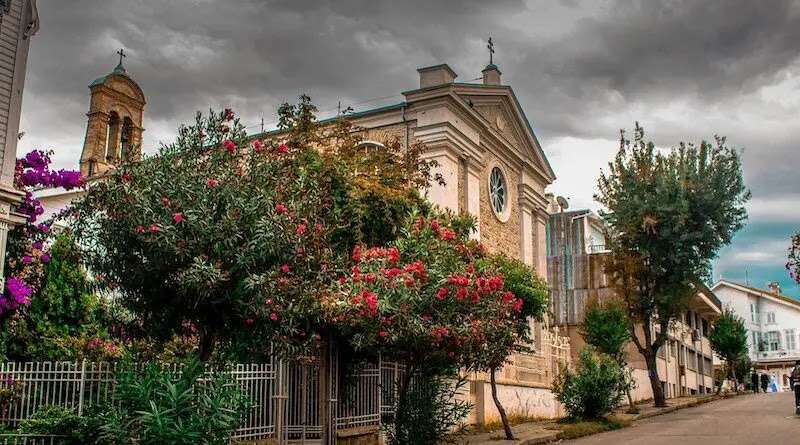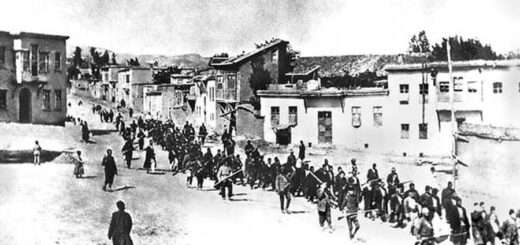Sourp Khach Armenian Apostolic Church On Büyükada: The Island’s Unforgettable Legacy

The Surp Asdvadzadzin Verapokhum Church, also known as the Church of the Assumption of the Virgin Mary, is a historic Armenian Catholic church located on Büyükada in Istanbul’s Adalar district. Photo Credit: Ozalphakan2, Wikipedia Commons
Eurasiareview
Büyükada, the largest of Istanbul’s Princes’ Islands, carries the traces of its multicultural history from the Ottoman era to the Republic. Rising amid pine forests on the island’s hills, the Soutp Khach Armenian Apostolic Church (Armenian: Սուրբ Խաչ Եկեղեցի) has been the spiritual center of the Armenian community since the mid-19th century, drawing attention with its architectural elegance and challenging fate.
Construction and Architectural Features: The Silent Testimony of Stone
The foundations of Sourp Khach Church were laid in the mid-19th century. Built in line with Armenian Apostolic tradition, the church was constructed in the late 1850s. While sources vary on the exact date, Ottoman archives confirm that construction began in 1856 with imperial permission. Architecturally, it follows the classic Armenian basilica plan: a three-nave structure centered on a cross layout. The exterior is clad in cut stone, featuring reddish andesite-like local stone, evoking the simplicity and durability of Van’s Akdamar Church. The roof is covered with a cylindrical dome, and the interior is adorned with Corinthian-style columns and remnants of frescoes. The eastern apse’s main altar is decorated with reliefs symbolizing the Holy Cross. Standing approximately 15–20 meters tall, the church’s bell tower dominates the island’s skyline. This architecture reflects the craftsmanship of Armenian masters during the Ottoman period, seen in other Armenian churches in Istanbul, such as Sourp Khach in Üsküdar.
Construction Funding: The Generosity of Philanthropists
The church’s construction was entirely funded by the community. Prominent Armenian merchants and philanthropists, led by figures like Andon Ağa Apelyan, collected donations. Apelyan personally oversaw the opening and covered a significant portion of the costs. As required by Ottoman decrees, expenses were managed through local Armenian foundations, reflecting the self-sufficiency tradition of minority communities. The total cost is estimated at 10,000–15,000 gold liras in the period’s currency—comparable to the construction of other churches on the island, such as the San Pacifico Latin Church. Funding was overseen by community councils to ensure transparency.
Community and Worship Tradition: A Spiritual Collective
Büyükada’s Armenian community in the 19th century consisted of merchant families who settled on the island. Sourp Khach,, affiliated with the Apostolic denomination, is under the jurisdiction of the Armenian Patriarchate of Istanbul. The community swells in summer with Istanbul-based Armenians migrating to the island, while in winter, numbers drop to 50–100. Worship follows traditional Armenian rites: Sunday liturgies (Badarak), the Feast of the Assumption (August), and the Exaltation of the Holy Cross (September) are the most significant events. Hymns by composers like Gomidas Vartabed are performed, with the choir forming the cultural backbone of the community. Though the community has shrunk due to younger generations’ migration, it maintains its spiritual ties through blessings by figures like Patriarch Mesrob II Mutafyan (d. 2009).
6–7 September 1955 Pogrom: A Dark Turning Point
One of the most tragic chapters in Turkish history, the 6–7 September 1955 events, also struck Sourp Khach Church. Triggered by tensions over Cyprus, the pogrom targeted minority neighborhoods in Istanbul, with attacks on Armenian, Greek, and Jewish properties. On Büyükada, the church and surrounding Armenian homes were looted, icons destroyed, and the bell tower damaged. Official reports note that 30 of 73 churches were burned, and Sourp Khach was among those affected. The events left 15 dead, hundreds injured, and thousands displaced, accelerating the Armenian community’s exodus from the island. The church became a spiritual symbol in the aftermath, hosting calls for solidarity from the Patriarchate.
Following the pogrom and community migration, the church fell into disrepair from the 1960s to the 1980s—remaining neglected for about 20–25 years, with its roof collapsed and walls overtaken by ivy. This period coincided with the island’s opening to tourism, leaving the church a forgotten ruin. Restoration began in the 1990s through the initiative of community foundations. In the 2000s, with support from the Armenian Patriarchate of Turkey and the Ministry of Culture, comprehensive restoration was undertaken, completed around 2010 at a cost of 1–2 million TL. Stone cleaning, dome repairs, and fresco restoration were inspired by the restoration of Akhtamar Church (2007). The church was reconsecrated in 2012 by Archbishop Aram Ateşyan and reopened for worship.
Concerts: A Cultural Rebirth
Today, Sourp Khach is not only a place of worship but also a cultural stage. As part of the Istanbul Music Festival’s “Music Route,” the church hosts classical music concerts. Works by Komitas Vartabed and Ahmet Adnan Saygun resonate within its walls; between 2015 and 2023, artists like the Borusan Quartet and Mercan Dede performed here. During the island’s summer festivals, the church’s acoustics are ideal for jazz and choral performances. These events rejuvenate the community and boost tourism—drawing over 5,000 visitors in the summer of 2024 alone.
Current Usage: A Living Legacy
As of 2025, Sourp Khach Church is an active place of worship, with weekly services in summer and rotational use by the Patriarchate in winter. The community consists of a core group of 100–200 people, showing recovery post-pandemic. It is open to tourists with free entry and guided tours available. Designated as a cultural heritage site, ongoing restoration is supported by foundation donations. The church reinforces Büyükada’s identity as a “music island,” enriching the island’s cultural map alongside the San Pacifico Church.
Sourp Khach Armenian Church, perched on Büyükada’s quiet hills, tells a story of hope rising from hardship. With its architectural elegance, philanthropic spirit, and cultural resonance, it carries the island’s multifaceted heritage into the future, inviting every visitor to listen to the stories etched in its stones.

Haluk Direskeneli
Haluk Direskeneli, is a graduate of METU Mechanical Engineering department (1973). He worked in public, private enterprises, USA Turkish JV companies (B&W, CSWI, AEP, Entergy), in fabrication, basic and detail design, marketing, sales and project management of thermal power plants. He is currently working as freelance consultant/ energy analyst with thermal power plants basic/ detail design software expertise for private engineering companies, investors, universities and research institutions. He is a member of Chamber of Turkish Mechanical Engineers Energy Working Group.





